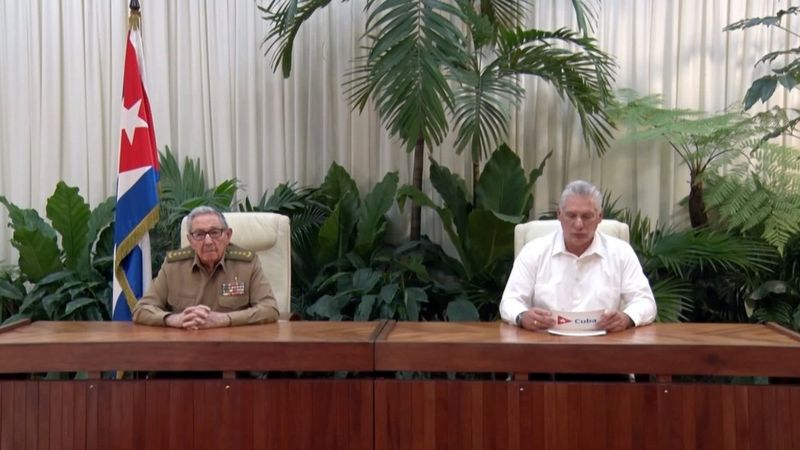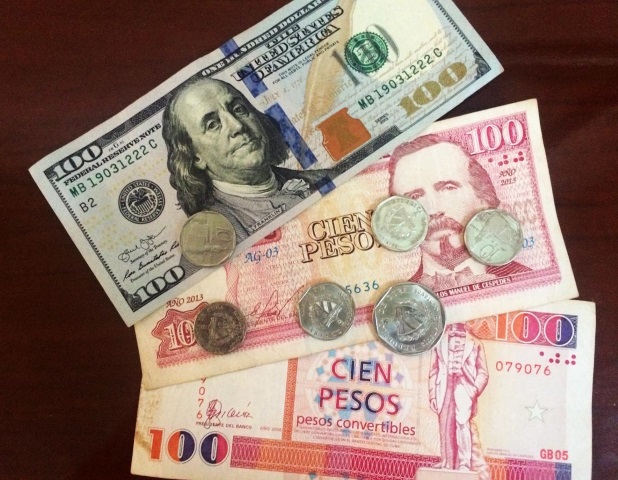On 10 December 2020, mysterious messages appeared across official Cuban media: “Tonight at 9pm there will be an announcement of interest to the population”.
The executive summary is that our advice to visitors about bringing money to Cuba has now changed. Visitors should preferably Euros, in cash, in good condition. US dollars in cash are not accepted by Cuban banks and are therefore hard to spend in Cuba.
The news of the upcoming announcement, which was also trailed on Cuban government social media accounts, sparked wild speculation as to what it might cover. Suggestions online ranged from the boss of the Cuban central bank having skipped the country with the nation’s currency reserves, to the invention of a Cuban COVID vaccine. Another more credible submission was that 89-year-old former president Raúl Castro, brother of Fidel, was on his deathbed.

At the appointed hour, President Miguel Díaz-Canel appeared on television alongside a silent-but-alive Raúl. The sombre announcement was that the long-planned monetary unification would take place on 1 January 2023.
Table of Contents
Monetary Unification
Those who haven’t previously been to Cuba might well ask what ‘monetary unification’ refers to. The answer is that Cuba has had two parallel currencies since shortly after the collapse of its former benefactor, the Soviet Union.
The Cuban Peso, also referred to by its ISO code CUP, or called Moneda Nacional (=domestic money), was created following Cuban independence in 1902. Reflecting the young country’s close economic and political ties with its nearest neighbour, the Cuban Peso was pegged 1:1 with the US dollar.
Following the 1959 Cuban Revolution, Cuba’s trade with the United States all but dried up and the Soviet Union became the main trading partner. Reflecting this, the Cuban Peso was pegged to the Soviet ruble.
In theory, for accounting purposes, the peso continued to be pegged 1:1 to the US dollar, a fiction that finally ended on 1 January 2023.
Following the collapse of the Soviet Union in 1991, Cuba found itself in an extremely dire economic situation – a time euphemistically known as the Special Period. Soviet oil stopped arriving, power plants shut down, the lights went out, irrigation pumps stopped running causing some crops to fail, and other produce rotted in the fields for lack of transport.
As a stopgap measure, Cuba allowed foreigners living in Cuba (mainly diplomats) to use US dollars. These could be spent in special shops selling imported goods, which were only open to foreigners.
Separate currency for foreigners and foreign things
After a brief period the Cuban government decided it would be better to issue a new currency for foreigners to use – and so the Cuban Convertible Peso was born. Also known as the CUC (pronounced cook), the idea was that this would be used for anything connected with ‘abroad’ – imported luxury goods, money spent by foreigners, and costs relating to Cubans going abroad for private travel.
Confusingly, both Cuban currencies used the same $ sign as US dollars. This made it inconvenient to distinguish Cuban money not just appearance-wise, but with calculations as well.
Ironically the Cuban Convertible Peso was never really convertible by the meaning of that word used in international finance. Tourists could normally change a few leftover CUCs at the airport when leaving Cuba. But international companies operating in Cuba always had tremendous difficulty turning profits earned in CUCs into dollars, pounds or euros to pay dividends to their shareholders. And Cuban state enterprises could have millions of CUCs in the bank, but would need to go through an approval process that involved the highest levels of Cuban government to be allowed to spend that money outside of Cuba.
For years through the 1990s and 2000s, the system of having one type of Cuban money for ‘foreign’ things and people, and another for ‘national’ things and people continued reasonably smoothly. But by the 2010s, Cubans were acquiring more CUCs through private businesses that dealt with foreigners, and buying more imported goods priced in CUC. It was realised that it was inefficient to have two parallel currencies and slowly it came to pass that most shops and businesses would accept payment in either CUC or CUP, at the prevailing exchange rate.
Contrary to belief among some visitors to Cuba, there have been no restrictions on changing between the two currencies for many years, and it’s not generally possible to live cheaply by getting ‘Cuban-only’ prices accessible only to those with CUP. It’s simply that higher-end restaurants would express prices in CUC, and basic foodstuffs like rice and beans would be priced in CUP; it’s possible to live cheaply by buying cheap food rather than eating in high-end restaurants.
The exchange rate between CUC and CUP was always fixed at 1:24 and 1:25 for changing cash (depending whether buying or selling CUP).
Accounting fictions for state entities
But for internal accounting within state enterprises (which still comprise most of the Cuban economy) and within the government itself, the fiction that 1 CUP is worth 1 US dollar was always maintained (until 1 January 2023). The effect of this was to hide the fact that many state enterprises are grossly inefficient. By some estimates around 40% of state businesses are in fact loss making. When the cost of (for example) diesel fuel shows in the accounts as about 5 cents per litre (20 cents per gallon) then it’s quite easy to be profitable on paper, but of course the reality is that the subsidy has to come from somewhere.
Under pressure to earn more hard currency in order to pay its way in the world, in 2019 the Cuban government opened a limited number of shops selling luxury imported goods which could only be paid for using USD (sound familiar?). These started off selling high-end domestic appliances and consumer electronics, but soon started selling imported food too. By December 2020 most imported food was sold only in these US dollar shops, and the CUC shops were relegated to selling little but Cuban rum and bottled water. These dollar shops are know as “MLC” shops and accept electronic payment only.

So, from 1 January 2021:
- The CUC ceased to exist as a separate currency, that is the two Cuban currencies were unified. Since late 2021, CUC banknotes are no longer accepted and are simple a historical curiosity.
- The (electronic) US dollar has taken the place of the CUC as Cuba’s second currency.
- The accounting fiction that 1 CUP = 1 US dollar has been abolished.
- The price of many goods and services used by Cubans which were effectively subsidised has been increased to more closely reflect their true cost. This has affected electricity, landline phones, and basic foodstuffs, among other things.
- Pensions and salaries of state employees will be increased to partially compensate for the increased prices. No longer will it be possible (or necessary) for Cubans to live on the equivalent of 1 dollar per day.
- The Cuban government has set the new official exchange rate of 25 CUP per 1 US dollar, for all purposes including changing cash and for government accounts.
Cuban people’s confidence has been shaken by these changes, not least by the fact that many things in Cuba can now only be bought with (electronic) US dollars.
Hard currency is now the rule
Previously we recommended using bank cards to withdraw cash from ATMs in Cuba, or bringing any cash except US dollars, and avoiding ‘unofficial’ money change services. Now, the opposite of all this is true – the best deal is to bring Euros in cash, and to change them on the black market!
What about greenbacks?
For a few months at the beginning of 2023, US dollars in cash were king. But due to difficulties with US sanctions, Cuban banks have stopped accepting US dollars in cash. This leads to the ironic situation where most shops show prices in US dollars, but there is no legal way to spend US banknotes in Cuba. There is a black-market allowing US dollar cash to be changed for Cuban Pesos, but the exchange rates are poor as the US banknotes are now only useful to people who are travelling outside of Cuba.
Our tour guides will be happy to help make sure you can change money safely at a favourable exchange rate.
Check out Young Pioneer Tours to Cuba here.
Read our Cuba Guide here.
For more information about the change in Cuban Money Policy, click here.





